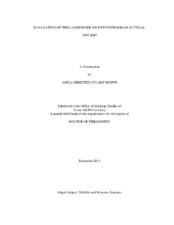| dc.description.abstract | The Landowner Incentive Program (LIP) was developed by the Texas Parks and Wildlife Department in 1997 in response to controversy and conflict between wildlife conservation agencies and landowners. The incentive was meant to encourage voluntary enhancement or establishment of habitat for rare species in the state, by providing technical assistance and a 75% cost-share. To evaluate the program in its first decade of existence, I gathered feedback from stakeholders via interviews, a mail survey, and case studies of LIP projects that focused on the black-capped vireo. The stakeholders I identified as administrators of the program, field personnel who acted as liaisons between administrators and landowners, and the landowners themselves. I used a qualitative theme analysis for interviews and open-ended survey responses to capture salient topics from the various perspectives. I analyzed closed-ended mail survey responses with descriptive statistics and ANOVA. For the case studies, I conducted vireo and habitat surveys and report the results with descriptive statistics or anecdotes.
Stakeholders were generally pleased with the program in its first decade regarding rare species habitat improvements. Most of the 126 projects were completed and resulted in an increase of habitat for a variety of species across the state. The funding sources changed over the decade, bringing with them new directives, but in general LIP investments benefitted rare and declining species, whether listed under the ESA or not. Relations between landowners and conservation agencies also seemed to be improved in some cases and to be created in others.
Every program has its difficulties to work through as it evolves, and LIP is no exception. The first 7 years of the program were state-administered and encountered a variety of modifications due to personnel changes and differing opinions on program priorities. In 2002, LIP became a national program, requiring Texas to compete for funds, and also federal clearance requirements that caused many administrative delays.
My recommendations for program improvement included improved monitoring of project outcome, immediate evaluation of participants, increased communication and cooperation among various agencies who work with landowners, and dedicated staff to assist all other stakeholders in the LIP process. | en |


